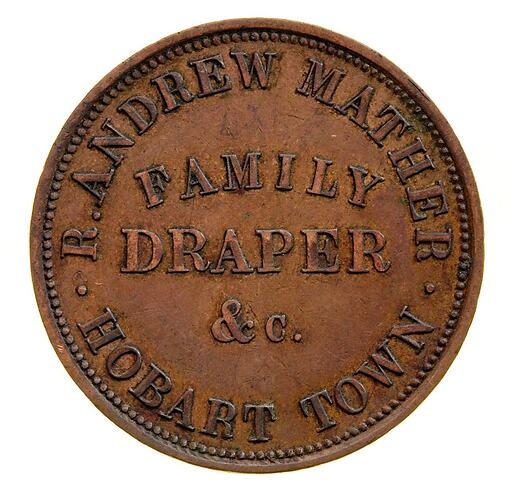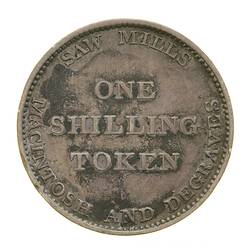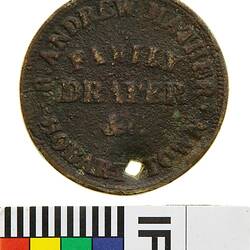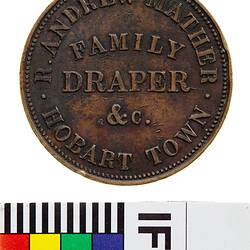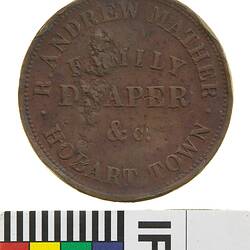This firm was established in 1849 in the Brock Buildings, Hobart. R. Andrew's father, Robert, was a Wesleyan and married Ann Benson, the daughter of Reverend Joseph Benson. Benson was a friend of John and Charles Wesley, the founders of Methodism. Mather decided to migrate to Van Diemen's Land and, after a false start (in the Hope, chartered by partners Hugh McIntosh and Peter Degraves who had the '1823 Tasmanian Shilling Token' struck - see narrative, MacIntosh and Degraves), arrived in Hobart in 1822.
According to Gardner, Robert Andrew Mather was born and educated in Tasmania and managed the business from its foundation until his retirement in 1876, when his sons Robert and Thomas took control, changing the name of the store to Andrew Mather and Co.. R. Andrew died in 1884. Thomas retired from the business in 1894, and Robert was still managing the store in 1910, assisted by his two sons.
In 1969 Roger McNeice wrote the same broad outline, but he stated that it was Robert Andrew Mather senior (the father of the man Gardner cites as the founder) who founded the firm in 1823, the year after the family's arrival in Tasmania. The Australian Dictionary of Biography supports this view. Robert Andrew Mather (senior) was born in 'Lauder, near Berwick upon Tweed, Northumberland, England on about 1 May 1782, he was apprenticed to a Scottish Hosier in London from the age of 14'. At the time of Mather's arrival in Tasmania on board the Heroine in 1822, McNeice states that 'All his merchandise had arrived before him, so it was not long before Mather established himself in business. For a few months he was in partnership with a Henry Hopkins, then in early 1823 he moved to London House, the name of the house and [draper's] business he had built.' Robert Andrew Mather (senior) died in Hobart on 26 March 1855.
Of these two histories of the Mather family and its business, the latter is to be regarded as the more authoritative, particularly as it concerns the establishment and founder of the business.
In September 1854, Mather ran two advertisements, one above the other in the Hobart Mercury. The first was addressed 'To country storekeepers and others,' and advised them that 'he is a large holder of Drapery Goods of almost every description,' and that orders that were received with 'a remittance or a reference to a town house' would be filled quickly. The second advertisement was headed 'New Goods', describing the contents of 'The first shipment of season goods', arriving at the store shortly, including 'Ladies Dresses and Shawls, in Llama, Barege, Tissue and Cashmere.lace Shawls.Ladies and Children's Bonnets' as well as 'a good assortment of Ladies' and Children's boots and shoes.'
Both R.A. Mather and Robert Mather signed the address presented to Irish Political Prisoner William Smith O'Brien when he was allowed to leave Tasmania, published on 4 July 1854. R.A. Mather was listed as a subscriber to the foundation of the Hobart Town Gas Company on 2 August that year. His fellow token issuers R.S. Waterhouse, Alfred Nicholas and O.H. Hedberg were also subscribers. Mather advertised in Hulll's Royal Calendar in 1859, and Walch's and McPhail's Tasmanian Almanacs during the 1860s. The advertisements ranged from a couple of lines to half pages.
Mather's most historically significant role is as a non-conformist Christian. He was one of the foundation trustees of the Wesleyan Church in Hobart but after his wife's death in 1831 he became, along with some of his children, a Quaker. This change in his faith came after meeting James Backhouse and G.W. Walker, the notable Quaker missionaries. Walker later married Mather's daughter Sarah. Mather was also briefly in partnership with Henry Hopkins, the man held to be the founder of the Congregational church in Australia, and a noted philanthropist. Hopkins endowed money to many charities and religious organisations, principally in Tasmania.
Gardner records that one of Mather junior's sons said of the tokens that 'I remember as a lad when the first shipment arrived from England, and can recall my late father, R.A. Mather, telling us that there was great difficulty in getting change in those days so that many of the business people decided to circulate their own.'
Roger McNeice has located a pair of letters, published in the Colonial Times on the first and second of April, 1856, that provide more information about when Mather began issuing tokens. The first was written by 'Grocer' who complained of the 'copper tokens which the owners are now circulating in great numbers,' and was worried that if the Mayor did not stop their use, more shopkeepers would use them. He was worried that as the copper in the tokens was not 'worth more than a shilling, in a pound. that, should the owners become insolvent, or leave the town, the public would lose some hundreds [of pounds].' 'Grocer' was also concerned that the low value of the tokens, compared to the coins for which they were substituted, enabled unscrupulous traders to profit on giving change; a strong incentive for having tokens struck.
R. Andrew Mather junior replied at length in the same paper the following day, arguing that if the government did stop the circulation of tokens 'the community would again experience inconvenience for the want of small currency.' which was the one of the main reasons for having the tokens struck. He went on to describe the kind of problems that had arisen because of the scarcity of small change, 'Your correspondent will perhaps remember the effect caused by the scarcity of change formerly, was - that some persons made it their business to collect the small silver and copper money, and to demand a premium of from five to ten percent for what they could gather.'
Against the charge of profiteering, Mather argued 'I, for myself, can assert that when I ordered those [tokens] which bear my name, it was entirely for the convenience of trade, and I accommodated my neighbours without any charge whilst I could spare them to them, and when I could not do so I refused to issue any more than the necessities of my own business required; as for making a profit by obtaining and circulating them I never sought it, and if a person thrust into circulation all that he imported, and the coin a fair weight the profit is very little; but when only issued as they ought to be, as legitimate change, and occupy a long period in the circulation, the profit amounts to nothing.' He advised that any issuer should, on request, change their tokens for 'British coin', and that any who 'were unwise or so unjust as to refuse' would quickly see tokens go out of circulation.
All four of the Mather tokens were issued bearing the same design, with the address of the store and its trade on the obverse, and a blindfolded figure of Justice with a cornucopia on the reverse. They were not dated, but judging by the above comments, they may have been issued over a period of some time. The tokens were made for Mather by Heaton and Sons of Birmingham. Mather's were still trading in Hobart in the late 1960s when McNeice published his book on Coins and Tokens of Tasmanian. At present Museum Victoria catalogue records that the tokens were issued c1860. On the basis of these letters, it seems likely that the first series were issued, at the latest, in either 1855 or 1856.
The Mather and Walker family papers are held by the University of Tasmania Library. The State Library of Tasmania holds portraits of two members of the Mather family, and one image of their business premises. The portraits are of Robert Andrew Mather, Senior, and of Thomas Mather. The photograph shows their premises in 1887, bearing the name Andrew Mather & Co., but the name above the door specifies that Thomas Mather (depicted in one of the above portrait photographs) was then the proprietor.
References:
Gardner, F. (1910). 'Trade tokens and the firms who issued them.' The Australian Storekeepers and Traders Journal. 31 October, p.11.
McNeice, R. (1969) Coins and Tokens of Tasmania 1803 - 1910, pp.66-67, pp.87-88.
'Mather, Robert Andrew'. Australian Dictionary of Biography. Vol.2, p.216.
Advertisement, Hobart Mercury, 20 September 1854, p4 (photocopy)
Advertisement, Walch's Tasmanian Almanac and Guide to Tasmania for 1863, advertisements p. 30.
Advertisement, Walch's Tasmanian Almanac and Guide to Tasmania for 1863, advertisements p. 41.
Advertisement. Hull's Royal Calendar for 1859. 1859, p.24.
Advertisement. McPhail's National Directory of Tasmania for 1867-1868. advertisements, p.17
'Robert Andrew Mather.' Portrait. Photograph, by Wherrett, Charles. Undated. Collection of the State Library of Tasmania. Internet catalogue record. Http://images.statelibrary.tas.gov.au/Detail.asp?ID=AUTAS001125883009. Call No.: AUTAS001125883009 page accessed 2/6/2005
'Thomas Mather.' Portrait. Photograph. Unknown creator. 1900. Collection of the State Library of Tasmania. Internet catalogue record http://images.statelibrary.tas.gov.au/Detail.asp?ID=AUTAS001126073501. Call No.: AUTAS001126073501 page accessed 2/6/2005
Andrew Mather & Co., 95 Liverpool Street. Photograph. 1887. Collection of the State Library of Tasmania. Internet catalogue record: http://images.statelibrary.tas.gov.au/Detail.asp? ID=AUTAS001125642587 page accessed 2/6/2005
More Information
-
Keywords
-
Localities
-
Authors
-
Article types
